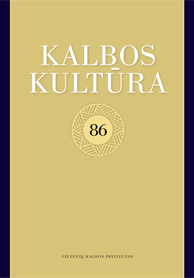JAUNŲJŲ VAKARŲ AUKŠTAIČIŲ KAUNIŠKIŲ KALBINĖS GIMTINĖS VAIZDINIAI: KAUNO, JURBARKO, ŠAKIŲ IR MARIJAMPOLĖS KALBINIS (NE)GIMINIŠKUMAS
IMAGES OF THE LINGUISTIC HOMELAND OF THE YOUNG WESTERN AUKŠTAITIANS OF KAUNAS: THE LINGUISTIC (NON)AFFINITY OF KAUNAS, JURBARKAS, ŠAKIAI, AND MARIJAMPOLĖ
Author(s): Laura GeržotaitėSubject(s): Theoretical Linguistics, Applied Linguistics, Phonetics / Phonology, Baltic Languages
Published by: Lietuvių Kalbos Institutas
Keywords: perceptual dialectology; Western Aukštaitian subdialect of Kaunas; linguistic homeland; linguistic affinity; drawn maps;
Summary/Abstract: The article is concerned with an analysis of a research of images of the linguistic homeland of young people from the locations of the Western Aukštaitian Subdialect of Kaunas: Kaunas, Jurbarkas, Šakiai, and Marijampolė. The subject material constitutes the data from a research conducted under the principles of perceptual dialectology. The images of the linguistic homeland embedded in the consciousness of the respondents can be uncovered through a discourse of the frequency of choice of linguistic codes and an analysis of the drawn (mental) maps of the tendencies of the localisation of the (non)affinity between the linguistic homeland and other locations. The analysis of the data has revealed that it is the subjects from the central locations of the area covered (meaning Šakiai and Marijampolė) who tend to associate their linguistic homelands with dialectal expression. It is likely that, owing to the singularity of a particular variation (the low degree to which it differs from the standard language), some of them are unable to recognise their own linguistic code. In recognising the existence of dialectal and non-dialectal expression in their linguistic homeland, subjects from Jurbarkas, a border zone of a subdialect, potentially confirm a coexistence of several linguistic variations in it. The linguistic code used in Kaunas most probably connects in the images of local school youth with a variation that approximates the standard language. Drawn maps show that, as far as linguistic affinity is concerned, local young people associate Šakiai and Marijampolė with the major part of the area of Western Aukštaitian Subdialect of Kaunas. The neighbouring border areas of Aukštaitians and Samogitians are considered linguistically closest to Jùrbarkas. The locations specified by Kaunas respondents as being closest to their linguistic homeland almost mirror the area of the standard language as identified in the second decade of the 21st century. The images of variation revealed by the attitudes of the young language users mirror the objective linguistic variation both of the subjects’ linguistic homeland and its surroundings, and of the entire area of the Lithuanian language to an almost exact degree.
Journal: Bendrinė kalba (iki 2014 metų – Kalbos kultūra)
- Issue Year: 2019
- Issue No: 92
- Page Range: 1-25
- Page Count: 25
- Language: Lithuanian

